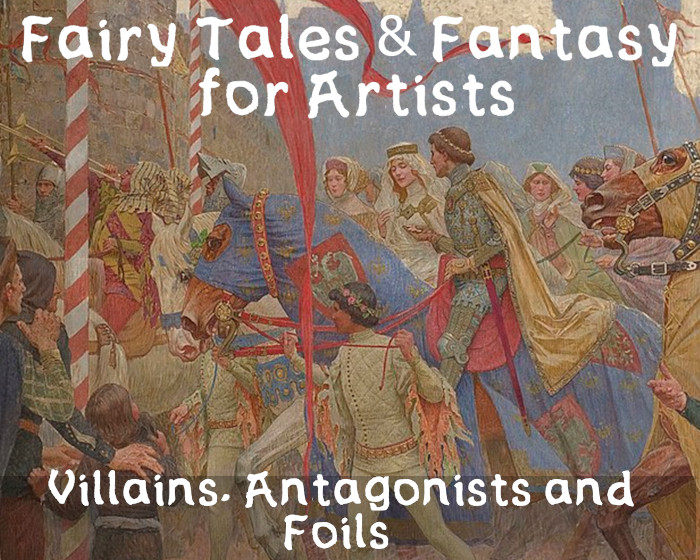Villains, Antagonists and Foils
by Ty Hulse
“The oldest and strongest emotion of mankind is fear, and the oldest and strongest kind of fear is fear of the unknown” ― H.P. Lovecraft, Supernatural Horror in Literature
Humans have long been strangely drawn to the villains of stories, which is why we have so frequently turned the terrifying into the romantic, such as has happened with Vampires. The Romanticists were “Mesmerized by the villain, by strangeness in beauty, by the corrupt and contaminated, the imperiled.” (Lutz)
Villains are freeing to write and so freeing to be an audience for. Villains can be wild, unpredictable, and fun. Unlike heroes neither the writer nor the audience needs to worry about understanding their every action. Instead, we can simply watch them enjoy themselves. Notice that in anime the villains are the ones who are always giggling, always gleeful. Similar to the villains of anime whose actions often bring philosophical debate the villains in Gothic literature often create complexity through “inexplicably meaningful actions.” In a similar vain T.S. Elion stated “it is better, in a paradoxical way, to do evil than to do nothing: at least, we exist”
In Medieval Romances fairies most often acted as supernatural challenges for the otherwise invincible heroic knights of these stories. These fairies act as tests that help to define knighthood and prove the knights worth. The fairies “ultimate freedom from moral constraints, combined with their propensity for arbitrary or illogical behavior, and, most visibly, their unmatched supernatural powers, make them dangerous beyond the normal – dangerous in ways that other adversaries, such as rival knights, opposing armies, or even giants and dragons, are not.” (Wade) What separates them from all else is their unknown, strange, and downright alien nature. Fairies never acted as expected, they created worlds that had different moral and logical rules than the knight would be used to dealing with. This makes the fairy the most dangerous and interesting challenge.
Fairies can serve a similar function in fairytales, for while the characters in these stories aren’t great warriors but poor peasants seeking their fortune, the fairies in these stories often act as a moral test for the heroes. Testing their cunning, work ethic, kindness, willingness to listen to the wisdom of others [especially their elders], and other similar traits necessary to the survival of ordinary people. The purpose of fairies in stories is to challenge the very nature of the hero in ways no physical threat could. When fairies were at their worst they were often depicted as being like the noble court, except without a purpose, they celebrate and go through the motions of nobility but serve nothing and no one. In fairy tales, ogres too represent a cruel nobility, they were depicted as living in mansions, and wishing to devour or force the peasants into work. Their constant thought was how they could exploit others. We no longer use fairies this way but in modern stories characters like Lex Luther and the Joker who act as agents of chaos and make Superman and Batman, respectively, question who they are, are good examples of the fairy type of villain.
The best villains in stories are often meant to act as moral and philosophical foils to their heroes. “Heroes and villains can present us with the challenge to transformation, possibly enabling us to see ourselves and others in a new light. The heroes and villains continually thrown up by human imagination can be seen as powerful prototypes representing the extremes of human response to boundary situations.” (Heroes and Villains By Mike Alsford)
With this in mind it becomes obvious why Tolkien, who had nearly died in the first major mechanized war made his villains cruel technocrats with no concern for the natural and good things of the world.
The Orcs, and by extension, the UrukHai are consumed by their work, by hardship and by cruelty. They are bedraggle depressed, violent, are completely disenfranchised and have no sense of compassion, intimacy or sense of social intercourse. They are the effect that industrialization and mechanization has had on society. They have no pride, they have no honor and they have no reason for being except to work, to produce and to consume.
Orcs were elves that were tortured and twisted by power hungry and greedy men, just as Tolkien felt that the greedy and power hungry autocrats twisted humanity into ugly and industrial colonists. Orcs represent the worst aspects of Europeans, the cruelty and maliciousness they hold for those outside themselves and the hate they even hold for each other.
"Do you know how the Orcs first came into being? They were elves once, taken A ruined and terrible form of life" (Tolkien 442). It is through descriptions like this that we are led to the realization that industrialization, technological “advancement” such as bio-engineering and mechanization lead to a twisting and negation of all of those aspects of humanity which make us human. It is through too much greed, too much yearning for knowledge and too much of any good thing that leads to something perverse. What is good, beautiful, useful and sustainable can indeed be too much if it is used in the wrong way, for the wrong purpose. (Hewitt)
Making industrialization the enemy reflects Tolkien’s own view of trees for which he acknowledges a deep love. He says in one of his letters: “I am (obviously) much in love with plants and above all trees, and always have been; and I find human maltreatment of them as hard to bear as some find ill-treatment of animals” (Tolkien, Letters, 233). He adds, “I take the side of trees against all enemies” (qtd. In Curry55).
Having clear cut evil villains and empires within a story, such that the good heroes can easily defeat the problems of the world has psychological value for audiences, as does having heroes with “pure motivations, a redemptive task and extraordinary powers” (Lawrence and Jewett, 2002).

















0 comments:
Post a Comment